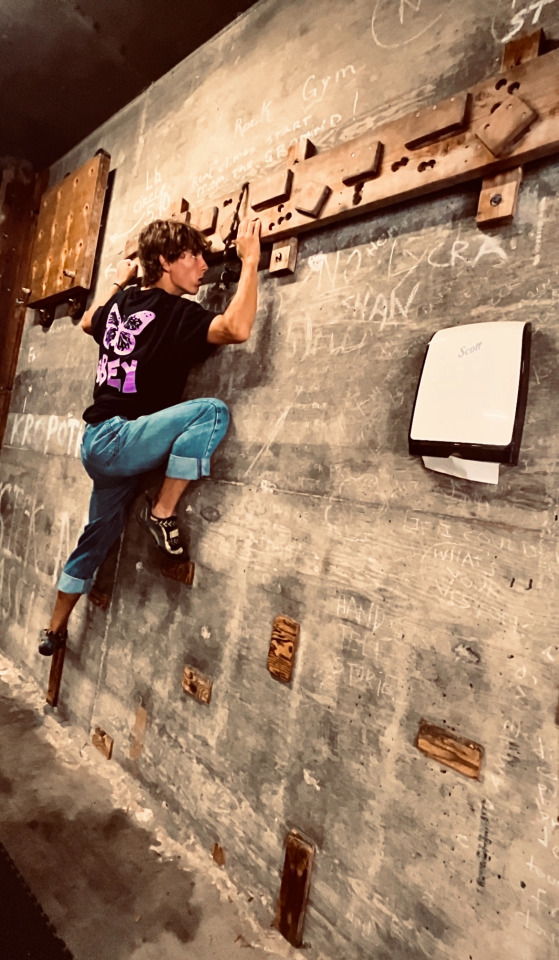#hangboarding
Explore tagged Tumblr posts
Text
.
#professional meetings DONE. submitted a piece of the law review app. pad thai. nick + hangboard. rp. great fuckin day to be alive#j.2025.all
4 notes
·
View notes
Text
5 notes
·
View notes
Text
How to Improve Your Strength for Climbing
Climbing is more than just a sport; it’s a full-body challenge that requires a mix of physical strength, mental fortitude, and technical skills. If you’re looking to enhance your climbing performance, focusing on how to improve your strength for climbing is essential. This guide will walk you through the best exercises, techniques, and tips to build the power you need to conquer tougher routes…
#Balance#bent-over rows#breathing techniques#climber training#climber workout#climbing challenges#climbing exercises#climbing focus#climbing goals#climbing improvement#climbing journey#climbing performance#climbing power#climbing recovery#climbing routine#climbing skills#climbing strength#climbing techniques#climbing tips#core exercises#core strength#dead hangs#dynamic moves#dynamic stretching#Flexibility#foam rolling#forearm endurance#grip strength#grip training#hangboard training
0 notes
Text
FERRO CONCEPTS DEBUTS THE HANGBOARD
Ferro Concepts has debuted their latest in tactical kit with the new Hangboard. Ferro Concepts state “The Hangboard™ is a one-row by six-column section of MOLLE that attaches to carriers just like The Dangler™ and The Mini Dangler™. Utilizing a 3”x9.25” section of hook and loop, The Hangboard can be tucked under front flaps or in the plate bags. Turn things like our 6×5 and 6×9 General Purpose…

View On WordPress
0 notes
Text
youtube
I made a thing! It's a tool to measure finger strength, you can use it figure out how much force you put into a hangboard in grip positions you can't hang with. In the video I explain how you can make your own, alternatively if you don't like watching videos you can just read the README on my github repo (https://github.com/Jan-de-Munck/scale) and follow the instructions from there
#climbing#finger strength#training#rock climbing#bouldering#fitness#open source#programming#electronics#hobby projects#video#Youtube
3 notes
·
View notes
Text





Fucking AWESOME active day today after work
18:30-19:30 lifting for the first time in a long time!
Bench 20kg 1x10 warmup, 30kg 5x10
OHP 20kg 3x10, 10kg (or 15?) 1x7 behind the neck OHP
DB incline bench 8kg 3x12
Skull crushers 10kg 3x10 superset with…
DB lat raise 3kg 6x15kg superset with…
Tricep cable pulldowns 14kg 3x12 (+3 on the last set)
Went with an Egyptian NB I met off of bumble!! I helped them with form. I’m SO stoked tho bc I have been WANTING to get back into lifting for MONTHS but didn’t know how to get access to a gym without paying for a separate membership. And I find out that they can invite me as a guest omg it’s so perfect. It’s fate.
19:30-20:00 biking to the climbing gym
20:00-22:00 doing my physical therapy exercises and stretches and hangboard exercises
10x10s hangs with 50s pause between
Pull-ups 10, 6, 6, 6
I think I’ll try doing pull-ups twice a week and maybe adding load to it???? I have never done weighted pull-ups in my life, but my Klimbing Krush is a big tryhard and inspires me to actually try harder
2 notes
·
View notes
Text
Bouldering Basics: How to Climb Stronger, Safer, and Faster
Bouldering—climbing short, intense routes without ropes—is a thrilling way to build strength, problem-solving skills, and confidence. Whether you’re starting at a gym or eyeing your first outdoor boulder, this guide breaks down climbing techniques, essential safety tips, and targeted strength drills to help you climb smarter. Plus, discover how a bouldering watch elevates your training with route tracking and performance insights.

1. Core Bouldering Techniques: Master the Fundamentals
A. Footwork: The Foundation of Balance
Edging: Press the edge of your shoe onto small footholds (e.g., on slab routes) — keep hips close to the wall to reduce arm strain.
Smearing: Use the rubber of your shoe to stick to featureless surfaces by applying downward pressure (common on vertical or overhanging problems).
Tip: Practice “stepping through” (crossing one foot in front of the other) to maintain balance on dynamic moves.
B. Handhold Mastery: Grip with Purpose
Jugs: Large, secure holds for resting and planning—grab them with a relaxed grip to save energy.
Crimps: Grip small edges with fingers bent at the first joint; start with shallow crimps and gradually increase difficulty to avoid pulley injuries.
Pinches: Squeeze holds between thumb and fingers for aretes or slopers, engaging your forearms and core for stability.
C. Body Positioning: Move with Efficiency
Dynamic Moves: Controlled jumps between holds—use hip momentum to generate power, landing softly to stick the grip.
Static Climbing: Smooth, controlled movements for delicate balance problems (e.g., slab boulders), focusing on slow, precise foot placements.
2. Must-Have Bouldering Gear for Beginners
**A. Bouldering Watch
Route Tracking: Log attempts, solve times, and grade progress with GPS or gym-based mapping (e.g., EZON Sports Watch auto-tracks climbs and syncs to Strava).
Performance Metrics: Monitor heart rate during intense bouts to avoid overtraining; use recovery insights to schedule rest days.
Durability: Shock-resistant and water-resistant designs (10ATM) for outdoor use, with long battery life for all-day sessions.
B. Climbing Shoes
Indoor/Moderate Routes: Versatile shoes with moderate downturn (e.g., La Sportiva Tarantula) for comfort and edging ability.
Steep Boulders: Aggressive, downturned shoes (Scarpa Instinct) to maximize toe power on overhangs.
C. Safety Gear
Crash Pad: 4–6 inches thick with dual-zone foam (e.g., Mad Rock Mad Pad) to absorb falls; always climb with a spotter for highballs.
Chalk Bag: Belt-mounted bag with a brush holder to keep hands dry and clean holds mid-route.
3. Strength Drills to Crush Your Projects
A. Finger Strength Training
Hangboard Basics: Start with 10-second hangs on jugs (3x5 sets, 60-second rest) — progress to smaller holds (slopers, crimps) over 4–6 weeks.
Grip Diversity: Train open-hand, crimp, and pinch grips separately to build balanced strength (e.g., 2x/week for 20 minutes).
B. Core & Back Strength
Dead Bugs: Lie on your back, extend opposite arm/leg to improve anti-rotation strength (3x15 reps per side).
Plank Variations: Side planks with hip lifts and weighted planks to support torso stability on dynamic moves.
C. Power & Explosiveness
Bouldering Specific: Repeat 3–5 V0–V2 routes with 2-minute rest to build anaerobic endurance.
Plyometrics: Box jumps and explosive push-ups to enhance dynamic movement power (2x10 reps, 3 sets).
4. Outdoor Climbing: Transitioning from Gym to Crag
A. Route Selection
Start Low: Begin with V0–V2 boulders to practice outdoor features (crimps, slopers, and heel hooks).
Study the Problem: Observe the route from the ground, noting key holds and foot placements before your first attempt.
B. Safety First in the Wild
Landings: Check for rocks, roots, or uneven ground—position your crash pad to cover the entire fall zone.
Warm-Up Thoroughly: Climb easy routes and do dynamic stretches (arm circles, hip swings) to prevent shoulder and finger injuries.
C. Weather Awareness
Wet Rock: Avoid climbing on sandstone or limestone when wet—use a bouldering watch to check real-time weather forecasts and precipitation alerts.
5. Safety Tips for Every Climber
A. Warm-Up Rigorously
10-Minute Routine: Climb easy boulders, do finger stretches, and activate core muscles to increase blood flow.
B. Fall Safely
Tuck and Roll: When falling, tuck into a ball, land on your crash pad, and roll to distribute impact—never stick your arms out to break falls.
C. Rest and Recover
48-Hour Rule: Rest fingers for 2 days after intense crimping sessions to avoid tendon injuries.
Track Overtraining: Use your bouldering watch to monitor resting heart rate— a 5 BPM increase signals the need for extra recovery.
6. Sample 4-Week Training Plan
Week 1–2: Technique & Foundation
3 Days/Week: Focus on footwork drills and easy boulder problems (V0–V1).
Strength: 2x/week finger hangs (jugs) and core work.
Week 3–4: Intensity & Power
4 Days/Week: Add dynamic routes (V1–V2) and 1 day of explosive drills (box jumps, campus board).
Rest: 2 days of active recovery (yoga, walking) to improve mobility.
Climb Smarter, Not Harder
With the right climbing techniques, targeted strength drills, and a reliable bouldering watch to track progress, you’ll build confidence and efficiency whether in the gym or during outdoor climbing adventures. Remember, bouldering is as much about problem-solving as physical strength—approach each route with patience, prioritize safety tips, and let every send (successful climb) be a step toward mastery.
Gear up with EZON’s durable, feature-rich bouldering watch to log every climb, analyze performance, and stay safe on the rocks. Ready to start? Lace up your shoes, chalk up, and let the boulders be your classroom—every hold is a lesson in strength, strategy, and perseverance.
EZON Watch: Professional sports technology brand https://ezonwatch.com
0 notes
Text
the secret wisdom of training for climbing is that not even the most dogshit climbing session is as painful as a single hangboard training session. hence you should endeavour to climb as often as you can so that you never actually have to train.
#ten minutes on the metolius rings they said#it'll be fun they said#my forearms ceel like they are fucking exploding#jocko homo
0 notes
Text
Would love to show more people the very cool colours of my bruises from dropping the hangboard but you can't just be sending pics of your feet to people
1 note
·
View note
Text
My hangboarding has gotten super weak. I used to be able to regularly do pull ups on a 20mm and have done them on a 10mm edge. Now I can't even hang off the 20mm one :(
0 notes
Text
Extraordinary Toys For Kids on Etsy - Gift Idea #1339016306
Ergo | Training Climbing Fingerboard Hangboard Equipment For Fingers & Grip Strength Beginner To Advanced BoardBrought to you by a shop owner on etsy.com. They would certainly appreciate your visit to see it, favorite ❤️ it, or even buy it as your next gift to give!GET THIS ON ETSY.COM Follow Art+Science Designs On Social Media Too!

View On WordPress
0 notes
Text
Indoor Rock Climbing | Overcoming Indoor Climbing Challenges

Overcoming mental challenges as well as overcoming the fear of climbing are few of the challenges beginners face during indoor rock climbing. Challenges are a part of growth, learning new techniques and a gateway to learning new skills. In this blog post, you can explore various common challenges and provide practical tips and insights on how climbers can conquer them.
Fear of Heights:
As a new climber, getting jitters or having fear of heights is very common. To conquer this challenge, focus on gradual exposure and visualization. Start with lower climbs, visualize success, and work your way up progressively. Remember, each successful ascent builds confidence, helping you rise above the fear.
Grip Strength:
Developing and maintaining grip strength is vital for climbers. Overcome this challenge by incorporating targeted exercises into your routine. Finger strength trainers, hangboard workouts, and consistent indoor rock climbing sessions will fortify your grip, making those challenging holds more manageable over time.
Route Reading:
This is one of the biggest challenges on the wall. Route reading is one of the solid bases of fundamentals. With repertoire and observing experienced climbers, you can get a better understanding on accessing different boulders. After you nail down the basic techniques, the route routing will naturally come to you, as you practice.
Endurance Building:
Having good endurance is key to having sustained climbing. Endurance training can be incorporated through high intensity interval training, cardiovascular endurance exercises, and aerobic conditioning. Learn pacing yourself while you are on the wall, to have a sustained climb.
Tips to Climb to Top Successfully for Beginners
Indoor rock climbing does have its challenges, but it also becomes rewarding and easier with time. It also gives a sense of achievement after a successful climb. Here are a few tips to get better quicker as a beginner.
Seek Guidance: While starting out, having a good mentor and fellow climbers to cheer you on are very important. Understand the basics of rock climbing to build a good foundation.
Cross-Training: Explore cross-training activities to enhance overall strength and flexibility, addressing specific weaknesses that may hinder your climbing performance.
Embrace Failures: Failure is an essential part of learning a new skill. With repetitions, you will learn to properly pace yourself, hone the footwork and grip. Hence, go to an indoor climbing gym where you will have a sense of community and people surrounding you will also cheer you.
Indoor rock climbing challenges are not roadblocks; they are stepping stones to mastery. Embrace each challenge as an opportunity to evolve and refine your skills. By incorporating these strategies into your climbing journey, you'll not only overcome obstacles but also emerge as a more resilient, skilled, and confident climber. So, gear up, chalk your hands, and conquer the vertical world.
0 notes
Text
Weekly Personal Reflection
Hello everybody! This is Sean, checking in for my first weekly reflection. Whenever life gets difficult, and I feel overwhelmed, I love to play sports. All my life, club sports and outdoor recreation have been my saving grace. I know that whatever is happening in the world, however I may feel, however much work that I have for school or extracurriculars, I can show up to practice and play my heart out for a while. That sense of consistency is much needed in my life and is extremely comforting for me. During college, I have aimed to continue this lifestyle. Specifically, I love to play pickleball and rock climb with my friends whenever I have free time. This quarter, my difficult workload from my extracurricular will make is even more difficult for me to focus and stay emotionally centered. Thus, it will be twice as important for me to find time to care for myself and do the things I love. Although sports are an important part of self-care for me, they are not the only thing that is important to me. For the entirety of my life and therefore also my academic career, I have maintained a good sleep schedule, getting at least 7 hours of sleep every night. This quarter, I have already started to violate my rule of sleep and ruin my sleep schedule. Sleeping is a very important part of maintaining alertness and capability during the day, and as such, I plan on prioritizing it more as the quarter goes on. All of this being said, I find difficulty in prioritizing self care when I am so busy, and so I hope that I can find some happy medium in the time to come. To me, I feel that I must sacrifice the quantity and quality of my free time in order to achieve my academic and extracurricular goals this quarter. I hope that I am mistaken, and will try my best to prove myself wrong.
Here is a picture of me working out on a hangboard for rock climbing:

0 notes
Text
Weer terug uit NZ
Jeetje, het jaar is voorbij gevlogen. En zo ben je na een jaar niet klimmen (lang leven mijn hangboard) weer in bleau.
We hebben zo veel geleerd over onszelf, ons systeem, wat we fijn vinden, etc. Eén van de zaken waar we enorm van hebben genoten, is het uitzicht. Dat willen we wel nog een keer.
Ook ben ik tot de conclusie gekomen dat we toch wel een huis(je) in bleau willen. Daarom gaan mama, Sander, Levi en ik het laatste weekend van augustus. We slapen bij Fabian.
Vrijdagmiddag samen uit Zeist vertrekken. Druk op de weg maar redelijk op tijd in Oncy. Zaterdag bezoeken we 5 verschillende woningen. Daar zit zeker heel veel moois tussen!
Wij zijn er echt helemaal vol van en ik vind het super spannend. Ik kan er 's avonds helemaal slecht van slapen.
Zondagochtend rustig opstaan, bakker, ontbijt, etc. En een uurtje klimmen. Heerlijk bewegen. En heel gezellig met Leef. Vanwege Lies en Sophie die nog thuis zijn, springen we om 13 uur weer in de auto en zijn we tegen 19 uur weer thuis. Begin oktober rij ik op vrijdag in mijn eentje. Vrijdag op tijd weg want ik heb om 14 uur een afspraak bij Antwerpen voor een dexascan. Dat is informatief en zeker iets wat ik ieder jaar ga herhalen.
Zaterdag eerst klimmen. Ik probeer wat nieuwe 7c's maar ondanks de zon en warme weer, voelt het een klammig aan allemaal. Om 14 uur bij ons favoriete huis afgesproken met makelaar en klusjesman. Daar een uur geweest en mogelijkheden besproken. Ik vind het nog steeds geweldig en zie ons daar echt al zitten!
Zaterdagmiddag nog meer 7c's in andere gebieden proberen. Maar het lukt allemaal niet. Voelt lastig.
Zaterdagavond lekker zelf koken en vroeg naar bed. Heerlijk.
Zondagochtend vroeger weg dan gisteren. In Apremont klimmen. Vergis me weer hoe ver het lopen is. Ik klim met een hele aardige 59 jarige Fransman. We hebben het over van alles en nog wat terwijl we samen in een 7c werken. Heel gezellig en motiverend. Ik kan de boulder snel klimmen. Dat voelt heel lekker. Daarna klim ik me leeg in andere boulders en zit om 13.30 weer in de auto naar huis. Eerst even langs Milly voor lekkere taartjes. Man, wat heb ik het bos toch gemist.
1 note
·
View note
Text
What to consider when buying climbing gear?
Buying climbing gear is an important step for anyone getting into rock climbing or other climbing activities. Here are some key factors to consider when purchasing climbing gear:
Safety: Safety should always be your top priority. Make sure the gear you're buying is certified and meets relevant safety standards. Look for UIAA or CE certification labels on the products.
Type of Climbing: Consider the type of climbing you'll be doing: sport climbing, trad climbing, bouldering, alpine climbing, etc. Different types of climbing require specific gear. For instance, sport climbing focuses on quickdraws and ropes, while trad climbing requires a larger set of gear for protection placements.
Fit and Comfort: Climbing gear, especially harnesses and climbing shoes, should fit comfortably. Ill-fitting gear can affect your performance and safety. Try on harnesses, shoes, and helmets before purchasing to ensure a proper fit.
Harness: Look for a harness that's comfortable for extended periods of wear. It should have adjustable leg loops and a waist belt, as well as sufficient gear loops for your needs. Harnesses also come in different styles, such as lightweight for sport climbing or more padded for trad climbing.
Climbing Shoes: Climbing shoes should fit snugly but not painfully. Different shoes have different levels of aggressiveness, which affects performance. Flat shoes are more comfortable for longer climbs, while aggressive shoes are better for technical routes and bouldering.
Helmet: A climbing helmet is essential for protecting your head from falling rocks and debris. Look for a helmet that's comfortable, adjustable, and provides good coverage without obstructing your vision.
Ropes: The choice of ropes depends on the type of climbing you're doing. For sport climbing, a single dynamic rope is usually sufficient. For trad climbing, consider double ropes or a thicker single rope for durability. Pay attention to rope diameter, length, and UIAA/CE certifications.
Carabiners and Quickdraws: Carabiners come in various shapes and sizes. Choose ones that are appropriate for your style of climbing. Quickdraws are used to connect the rope to the bolts in sport climbing. Look for lightweight, durable options with smooth-clipping gates.
Protection (Trad Climbing): If you're into trad climbing, consider buying passive protection (nuts, hexes) and active protection (cams). Choose a variety of sizes to match different crack widths.
Belay Device: Belay devices are essential for belaying your partner. Look for devices that are user-friendly and suitable for your preferred belay style (auto-locking, tube-style, etc.).
Chalk and Chalk Bag: Chalk helps keep your hands dry. Chalk bags come in various designs and sizes, so choose one that's comfortable to wear and easy to access.
Training Equipment: Depending on your goals, you might want to invest in training tools like fingerboards, campus boards, and hangboards to improve your strength and technique.
Budget: Climbing gear can be expensive, so set a budget and prioritize your purchases based on what's most important for your style of climbing.
Quality and Brand Reputation: Stick to reputable brands known for their quality and safety standards. Quality gear will last longer and provide better performance.
Secondhand Gear: Be cautious when buying used climbing gear. While some gear like carabiners and quickdraws can be safe to buy used, it's generally recommended to buy certain items like harnesses, helmets, and ropes new due to safety concerns.
Remember that climbing gear is an investment in your safety and enjoyment, so take your time to research and choose the gear that suits your needs and preferences best.
0 notes
Text
Bought a hangboard

My fingers are about to get so goddamn strong
1 note
·
View note